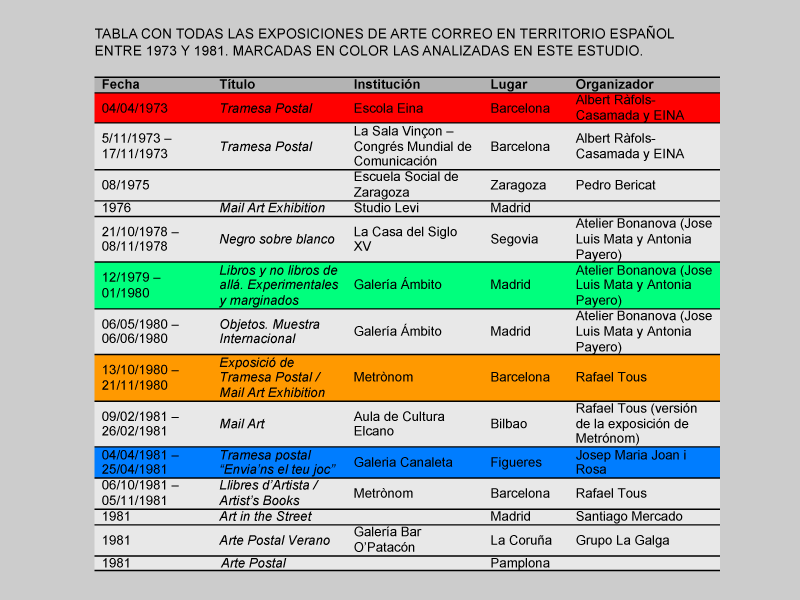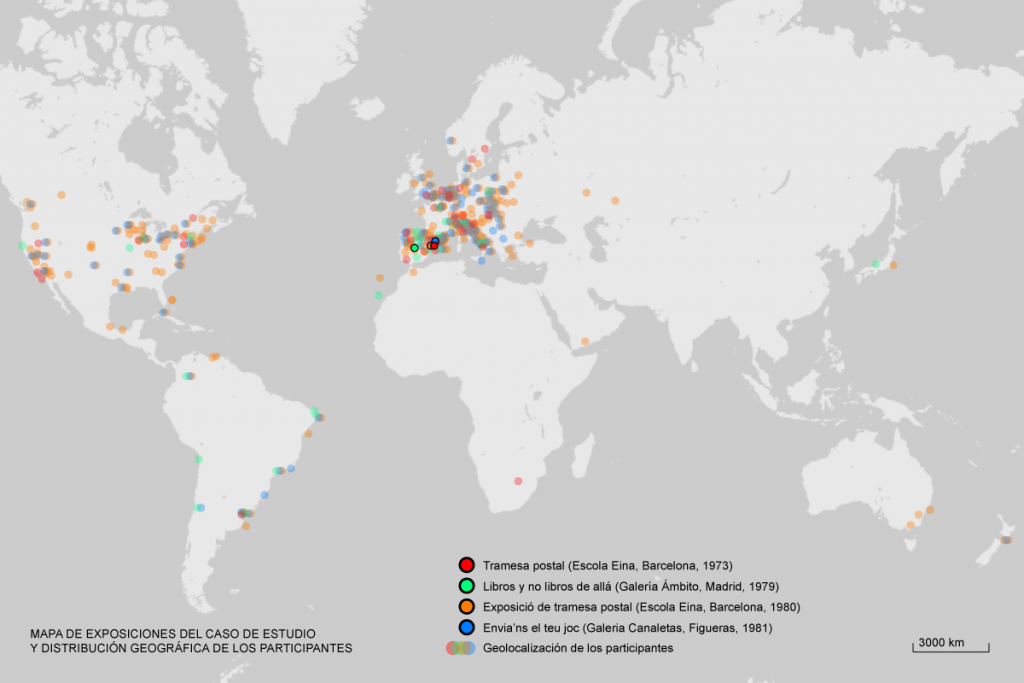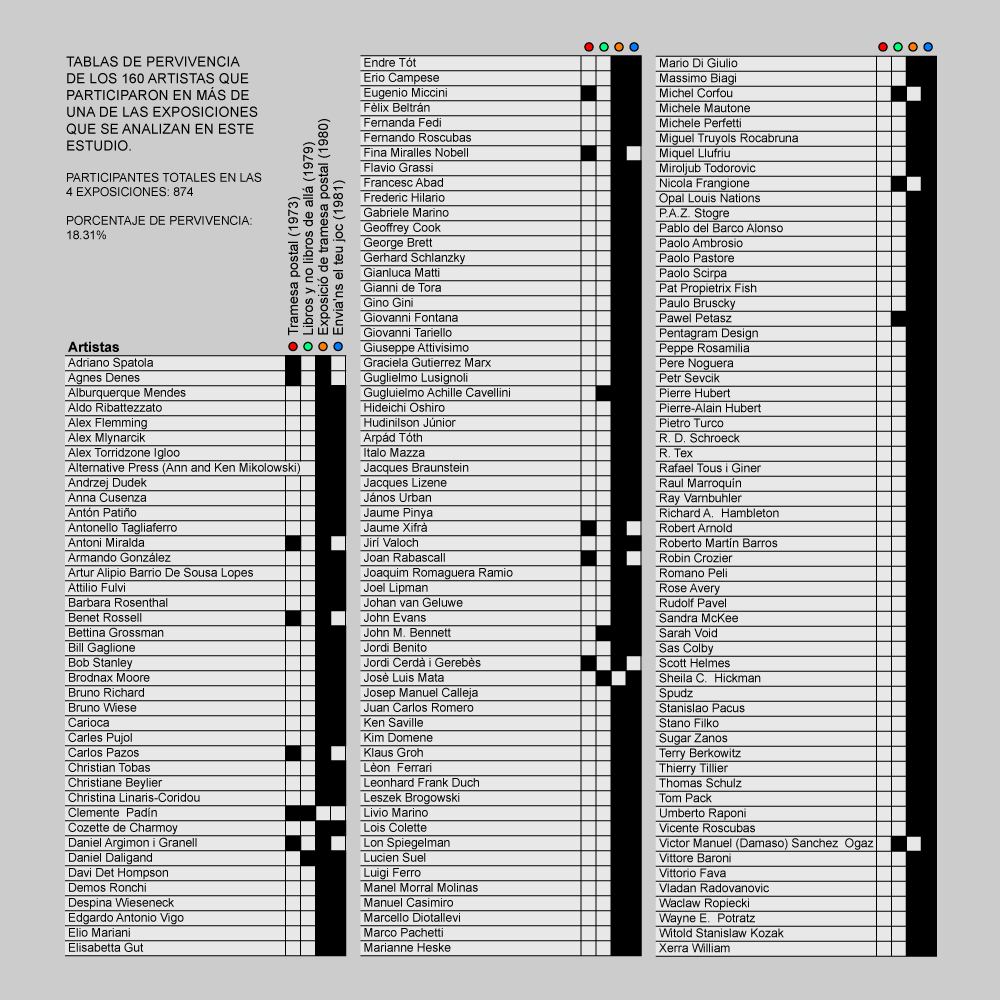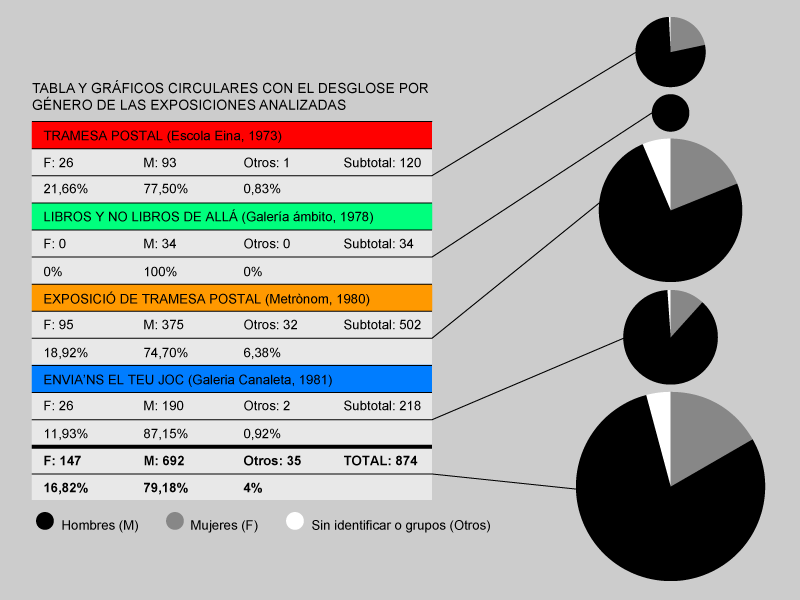1. Presentation of the case study
The practice of mail art is closely linked to experiments carried out in the sixties, seventies and eighties, such as visual poetry, conceptual and intermedia art[1]. This portable or mobile art emerged during the Cold War international period, when transport and communication were gaining momentum. The fast development of commercial aviation, the expansion of technologies such as the television, the telephone, fax or computers, as well as the quick deployment and growth of networks related with their use, introduced transportation and communication means into the imaginary of societies around the globe. The mail was related to both networks – transport and communication – and was popular, since its costs could be assumed by large sectors of the population.
Agents from the art field were actively engaged in mail art, which operated through networks of contact, exchange and solidarity. These practices aroused a particular interest among those artists or cultural agents who had a specific need of contact with other territories because of geographical or political isolation, or due to the absence of an art system related to their purposes. Under experimental, processual and conceptual premises, the works of art were adapted to transportable formats, one outstanding characteristic of which being their ability to be disseminated with limited means. The use of the postal system also allowed artists to escape state control and censorship.
Despite its location in Europe, the Spanish state remained at the margins of the international relations shaped during the Cold War period. The kind of opening up that characterized the last phase of Franco’s dictatorship – which attempted to instrumentalise both artistic practices and cultural policies – led from 1975 onwards to the so-called “democratic transition”. A significant increase of information coming from abroad, along with the emergence of an artistic system and a number of private initiatives, led to the consolidation of conceptual and experimental artistic practices in the country, including mail art.
This study collects and analyses mail art exhibitions that took place in Spain between 1973 and 1981. It maps these initiatives and draws a series of preliminary conclusions regarding the points of contact and/or disjunction between mail art produced in Spain and in other territories. In order to do this, it focuses on exhibitions. Each event operated in fact as a node through which the connectivity of relational networks was put into practice, and mail art’s materiality gained both local and international visibility thanks to displays accessible to a broader public.
This study departs from two observations; on the one hand, despite various attempts to review the phenomenon of mail art in Spain, no comprehensive study – especially on mail art exhibitions – has been carried out[2]. One the other hand, the lack of information regarding such practices could imply that it has been of little significance. However, the examination and comparative analysis of sources revealed in fact that this idea – mail art practices in Spain seeming of less significance – is mostly due to the absence of a more comprehensive study. Over the eight-year period analysed in this study, we identified fourteen exhibitions, as well as other types of initiatives or processes such as publications, artist’s editions, works of art made using the connectivity of mail art networks, etc.
The first exhibition dedicated to mail art in Spain was held in 1973 at the Escola Eina (Eina School) in Barcelona, under the title “Tramesa postal” (“Mail Delivery”). Since then, the number of events dedicated to mail art gradually increased. In 1981, in the midst of the “Transition” period, five exhibitions were organised, which seems to confirm the consolidation of a local network of internationally connected mail artists. During the eighties, and especially towards the end of that decade, the initiatives proliferated. In his book Mail Art – The Eternal Network, Pere Sousa identifies seven initiatives in 1987, four in 1988 and eleven in 1989. However, our study focuses on the first period of mail art exhibitions in Spain (1973-1981), leaving for further research the study of the phenomenon in its entirety.
Ill.1. Timeline of mail art exhibitions in Spain between 1973 and 1981.
Besides identifying and positioning mail art exhibitions on the Spanish territory between 1973 and 1981, we analysed more closely artists’ participation to four significant events: “Tramesa postal” at Escola Eina (Barcelona, 1973), “Libros y no libros de allá” at Galeria Ámbito (Madrid, 1979), “Tramesa postal / Mail Art Exhibition” at Metrònom (Barcelona, 1980), and “Envia’ns el teu joc” at Galeria Canaleta (Figueres, 1981). Our intention was to:
– Create a comprehensive list of exhibitions and incorporate it to MoDe(s)’ database
– Insert into the database the names of the participants to the four significant exhibition cases
– Export the data from the database and turn it into visualizations
These visualizations would allow us toe xplore different connections between the exhibitions by means of diagrams, tables and timelines, in order to confirm the emergence in Spain of an articulated core of agents related to these practices.
Analyse, through diagrams and maps, the connections between the mail art scene in Spain and international networks.
2. Methodology and data collection
In order to collect information for this study, we started with Pere Sousa’s compilation in his article “Cronología del arte postal en España 1973-1999”, published in Mail Art. La red eterna[3]. In this article, Sousa reports up to nine exhibitions between 1973 and 1981, a cipher that also appears in different works produced in the Spanish academic field over the last years[4]. To check the existence of other exhibitions, we relied on international archives and their online platforms, such as the Lomholt Mail Art Archive in Denmark and the Artpool Art Research Center in Hungary. The first one provided us with a reference to a mail art exhibition organized in 1981 in Madrid by the artist Santiago Mercado[5]. Thanks to the second, we found the trace of an exhibition organized by Pedro Bericat at the Escuela social (Social School of Zaragoza) in August 1975[6], as well as “Arte Postal Verano”, held in the gallery of the café “O Patacón” in La Coruña, in 1981[7]. The research was completed by visits to archives in different art institutions in Barcelona (MACBA, Fundació Miró, Escola Eina). They confirmed that the exhibition “Tramesa postal” at Escola Eina (1973) was displayed again a few months later at the Sala Vinçon in Barcelona, within the framework of the World Congress on Communication held in the city; as for the “Exposició de Tramesa Postal / Mail Art Exhibition” held at the Sala Metrònom in 1980, it was reconstituted a few months later at the Aula de Cultura Elcano in Bilbao, in 1981. Our research therefore led to the identification of five new events, in addition to the nine already known, for a total of fourteen mail art exhibitions.

Ill. 2. Table with mail art exhibition in Spain between 1973 and 1981.
After this first phase of identification of the exhibitions, we proceeded to insert their data in the relational database of the project MoDe(s). We included basic information – place, date, title, organizers – for each of the fourteen cases; in the case of the four case studies, taking advantage of the fact that we had their complete list of participants, we registered all their names, as well as their place of origin – their place of birth or, in the case of not being able to obtain it, their known place of residence – and gender. This opened up the possibility of cross-checking information related to the four exhibitions and, in addition, of reviewing possible intersections with other cultural events and case studies previously registered in MoDe(s)’ database. The result was an exhaustive quantitative record which, although it does not cover all the participants in the fourteen cases studied, does allow to articulate a series of observations on the expansion of mail art in Spain, as well as its reach at both national and international levels. The number of registered participants amounts to 874; some participated in one, two, and even three of the four events put under scrutiny. Of these, 160 participated in two or more exhibitions. The observation of this phenomenon allows us to draw a series of preliminary conclusions.

Ill. 3. Geographical distribution of participants to mail art exhibitions in Spain between 1973 and 1981.

Il. 4. Table of 160 artists who participated in more than one of the four analysed mail art exhibitions.

Ill. 5. Table and circular graphs with the gender distribution of participants to the four exhibitions.
3. Preliminary conclusions and questions
The recording, organisation and visualization of information by the means of MoDe(s)’ database allowed us to operate a first quantitative analysis of the mail art phenomenon in Spain. The combination of such quantitative study and qualitative analysis methodologies usual in art historiography made possible to articulate a first analysis, as well as a series of preliminary conclusions regarding the phenomenon of mail art phenomenon in Spain, taking into account its spatial dimension.
First of all, this study situates the Spain the world map of mail art activities developed during the seventies and eighties, highlighting the existence of networks of collaboration and exchange operating both within Spain and transnationally. By doing so, it is possible to challenge the historical account of a Spanish experimental art scene that is usually described as closed, isolated, with little communication to and from the outside. While previous studies, mainly related to conceptualisms, already nuanced this monolithic vision, the role of mail art in these processes of connection with other experimental practices and contexts still deserves further attention. Taking all this into account, we can raise a series of open questions: Is there a relation between the development of mail art practices and conceptual practices in Spain? What are the characteristics of mail art, and which ones facilitated intersections with other artistic disciplines and their agents? Is it possible to draw a profile of those Spanish artists involved in these practices and compare it with the profile of artists from other countries? To what extent is the Spanish political and social situation reflected in mail art projects, and establishes a dialogue with the production of other social and geographical spaces?
The study of mail art allows us to highlight a set of socio-cultural practices, along with their agents and productions, that has gone unnoticed until recently. This invisibility may be attributed to two factors: on the one hand, mail art’s highly informal nature, which, according to the terminology commonly used in the historiography of conceptualisms, can be described as dematerialised[8] or non-objectual[9]; its extra-institutional position kept mail art at the margin of the artistic institutions that allow and grant recognition in the field of art. In this sense, this work aims to complement the above-mentioned studies on mail art[10], as well as other recent initiatives, especially exhibitions, which directly or indirectly reaffirmed the importance of these practices in the context of the Spanish art scene[11]. The inclusive nature of mail art exhibitions – placed under the characteristic motto “no jury, no return” – made possible the inclusion of agents who operated out of the artistic and institutional circuits, be they museums, galleries, schools or universities. Since their activities have been so far hardly noticed by art historians, examining them through the lens of mail art offers an opportunity to do so.
The complete data of the four presentations also allows an analysis of participation from a gender perspective. Male participation is predominant, with an average percentage of 79.18%, while women represent 16.82%, and groups or participants whose gender could not be identified account for 4% (let’s precise that part of them were groups or collectives). Likewise, if we review the gender distribution in each of the four case studies, we find that the exhibition with the most female participation was “Tramesa postal” (1973) at Escola Eina. Eve though the number of cases is not very representative with respect to statistics standards, their observation suggests that the visibility of women through mail art did not improve over the years. We should point out that these figures are in line with, for example, the current presence of female artists in Spanish museums[12].
Finally, another interesting aspect in the study of mail art is the implication of local artists, and its consequences. When reviewing this phenomenon, it is necessary to take into account not only the national scale, but also differences between regions and cities within the national territory. A subsequent step would consist in comparing the spatial distribution of mail art exhibitions with the origin of their participants and their personal trajectories beyond the exhibitions. This third point was not carried out in that study; however, we can deduce from the four analysed cases that mail art seemed to challenge the centrality of those capitals and regions usually considered as centres of artistic and cultural production. Next to the poles of Madrid and Barcelona, cities such as Zaragoza, Segovia, Figueres, La Coruña, Bilbao and Pamplona come to the fore. At the international level, we can notice proposals sent from Eastern Europe and Latin America and, to a lesser extent, Australia and Asia.
In this way, the mail art contributed to a spatial de-hierarchization, articulating a geography of minor locations that acquire importance as points of origin of contributions, horizontalizing the conception of the transnational field of the experimental art. Nevertheless, we should specify that in this study, this operation of visual decentralization remains circumscribed to the exhibition itself and the diffusion of mail artefacts. Indeed, no account has been taken of the – professional, friendly, personal – exchanges between two agents, another essential aspect of mail art. In this respect, it is important to stress that there is currently no archive in Spain openly dedicated to mail art like the Lomholt Mail Art Archive or the Artpool Art Research Centre, which would facilitate a comprehensive study of such communication between peers[13].
Notes
[1] Higgins, Dick. Intermedia. The Something Else Newsletter, vol. 1, no. 1, febrruary 1966.
[2] Pilar Parcerisas in Conceptualismo(s) poéticos, políticos y periféricos. En torno al arte conceptual en España, 1964–1980. Madrid, Akal, 2007; Pere Sousa in Mail Art. La red eterna. P.O. Box, 2010 ; Irene Covaleda Vicente, En el Umbral del Mail Art a través de la mirada de Michael Haneke en Caché (2005) (doctoral thesis); Irene Covaleda Vicente, Fermer la porte. Ouvrir la carte postale. Propuesta creativa en torno al Mail Art (MA thesis); Isabel Lázaro, Evolución del Mail Art en España (MA thesis).
[3] This article was written by Pere Sousa himself for P.O. BOX magazine, of which he was editor between 1994 and 1999.
[4] See note numer 2.
[5] http://lomholtmailartarchive.dk/location/madrid/1981-03-03-mercado
[6] http://www.artpool.hu/MailArt/chrono/1975/Escuela.html
[7] http://www.artpool.hu/MailArt/chrono/1981.html
[8] Lippard and Chandler, “The Dematerialization of Art”, Art International, 12:2, February 1968, pp. 31–36.
[9] This concept was developed by art theorist Juan Acha, see: Juan Acha, Arte y sociedad. Latinoamérica: El producto artístico y su estructura. México: Fondo de Cultura Económica, 1981.
[10] See note number 2.
[11] “Ulises Carrión. Querido Lector. No Lea”, MNCARS, Madrid, 2016; “Muestreo#2. This is Mail Art”, exhibition, CEDOC, MACBA, Barcelona, 2017-2018.
[12] https://eprints.ucm.es/45332/1/2016_Pol%C3%ADtica%20y%20Sociedad_Ballesteros.pdf
[13] The Archivo Lafuente (Santander and Madrid) includes materials by Ulises Carrión and artists’ books, as well as works and correspondence by Spanish artists who were involved in the mail art network. However, the archive is not open to individual researchers but only collaborates with institutions. Furthermore, its collections does not focus exclusively on mail art.
4. Bibliography
Books
Pilar Parcerisas, Conceptualismo(s) poéticos, políticos y periféricos. En torno al arte conceptual en España, 1964–1980. Madrid: Akal, 2007
Pere Sousa, Mail Art. La red eterna. P.O. Box, 2010
Articles
Gloria Picazo, “Prólog/Introduction”, in Tramesa Postal/Mail Art, exh. cat., Barcelona: Metrònom, 1980, n.p.
For more information
Jean-Marc Poinsot, Mail art, Communication à distance. Paris: CEDIC, 1971.
Hervé Fischer, “Diffusions de masse et Communications marginales”, in Art et Communications marginale. Paris: Balland, 1974, pp. 5-18.
Fabiana Pianowski, “The Net Out of Control: Mail Art in Latin-America.” Published by Lomholt Mail Art Archive, n.d. Online in: <http://www.lomholtmailartarchive.dk/texts/fabiane-pianowski-the-net-out-of-control-mail-art-in-latin-america>
Kornelia von Berswordt-Wallrabe, Guy Schraenen and Kornelia Röder (eds.), Mail Art Osteuropa im internationalen Netzwerk, exh. cat., Schwerin: Staatliches Museum Schwerin, 1996.
Catalogs
Llibres d’Artista/Atist’s Books, exh. cat., Barcelona: Metrònom, 1981.
Mail Art, exh. cat., Bilbao: Aula de cultura Elcano, 1981.
Arte postal. Verano 1981, exh. cat., La Coruña: Galeria Bar O’Patacón, 1981.
Envia’ns el teu joc, exh. cat., Figueres: Galeria Canaleta, 1981. Poster.
Objetos. Muestra internacional, exh. cat., Madrid: Galería Ámbito y Atelier Bonanova, 1980.
Tramesa Postal/Mail Art, exh. cat., Barcelona: Metrònom, 1980.
Libros y no libros de allá. Experimentales y marginados, exh. cat., Madrid: Galería Ámbito and Atelier Bonanova, 1979.
Negro sobre blanco, exh. cat., Segovia, Madrid: La Casa del Siglo XV y Atelier Bonanova, 1978.
Archives
Escola Eina (Barcelona)
Artpool Art Research Center (Budapest, Hungary / online resources)
Centro de Documentación, MACBA (Barcelona)
Fundación Mirò (Barcelona)
Lomholt Mail Art Archive (Denmark / online resources)
Picture: Exposición Arte Postal Verano, Galeria Bar O’Patacón, A Coruña, 1981.


